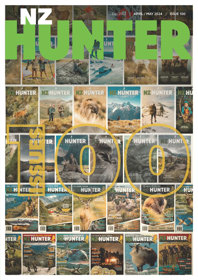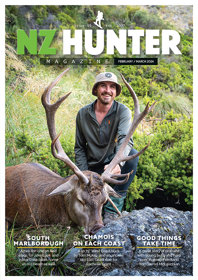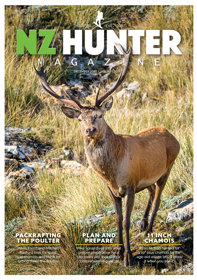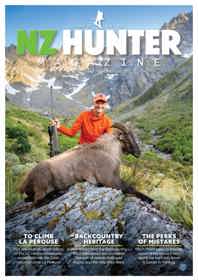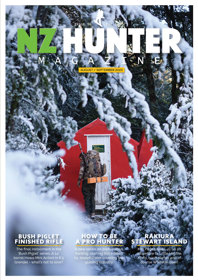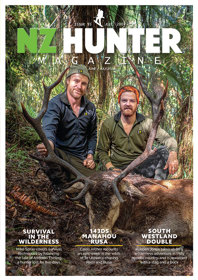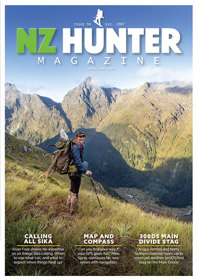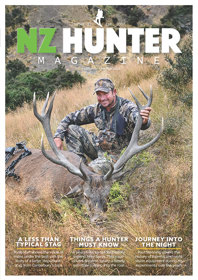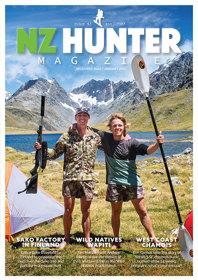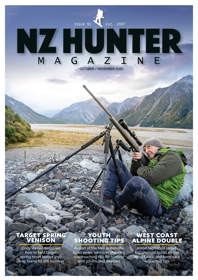Issue 91 - October/November 2022 | On Sale Monday 3rd October 2022
Spring is not far away now in many areas despite a very challenging winter, and depending on your altitude.
The very first shoots of Mountain tutu are just starting to appear on the warmest claypans in the Kaweka Forest Park, which means the Sika will be hoovering them up very soon.
KAWEKA 1080
While we were in the Kawekas doing a kiwi nest raid on Sunday, Ospri finally did the 1080 drop in the Eastern Kawekas that has been scheduled since July. The Kaweka Liaison Group agreed to this drop as a buffer zone along the Park boundary - not because there is any TB in the Park, but to stop the TB outbreak on Hawkes Bay farmland getting into the possums in the Park.
We were pretty disappointed at the signage at the Park access points, with only the usual pretty small standard poison notification signs and the word 1080 not very obvious at all. Yes, they all said Sodium monofluoroacetate in the bold heading at the top, but how many of the public know this is 1080? Unless you were aware of the impending 1080 drop, it would have been very easy to not notice this was anything more than the usual localised feratox or brodifacoum poison signs which few people read as they don’t effect Park users to any great extent. While this may meet Ospri’s signage requirements, it seemed crazy that there weren’t much larger signs at the main access points with the word 1080 clearly legible in large letters at the top. We will be following this up with Ospri.
KEA AND 1080
Increasing areas of public conservation land are being signalled for 1080 drops in the next few years by both Ospri’s TB eradication and DOC’s biodiversity programs. This has ramifications for not only our valued introduced species but also some very susceptible native species like kea – which are well known to consume cereal 1080 baits with large documented by-kills from some operations. I recently attended a kea/1080 workshop at DOC Rangiora, where Dr Laura Young from the Kea Conservation Trust and DOC’s kea program brought us up to date with their work on kea 1080 mitigation measures. There are certainly some promising looking kea repellent options being trialled at the moment that look good for the future. Another issue that we need to be dealing with asap that needs the same effort and resources put into it is finding an effective and affordable deer repellent that also repels kea. This is the only way we can protect not only our iconic native species but also our heritage deer herds, and minimise the conflict which is a huge waste of everyone’s valuable time and energy.
TAHR CONTROL
DOC’s tahr control work for the year should be finished by the time you read this, and you will be able to access the information on their website. As well as the yearly control plans we are working with the Department on a longer term plan for the management of tahr. This includes establishing some evidenced based vegetation bottom lines, attempting to deal with the increasing demand on the diminished tahr resource by both the commercial and recreational sector, and looking at ways to handle changes in budget due to the vagaries of government funding.
GAME MANAGEMENT
Recently I’ve been hearing a little commentary /uncertainty around game animal management – mostly due to a lack of understanding about what this actually means. Game animal management will be hugely varied across our game animal herds and places, depending on what the desired hunting, conservation and wider community outcomes there may be for each herd and place.
It is far from one size fits all. Think of it as a series of overlays that we apply across all the areas where game animals exist. The more specific the management objective is for a place and herd the more layers of management will be required.
At its simplest level, the overlay that covers the whole country may just be about getting more people out in the hills and making them more successful whatever. The future of hunting and our game animals depends on us being able to do this. The overlay on top of this could be influencing some hunter behaviour by encouraging them to target more breeding females where needed whether they are harvesting meat or looking for trophies or both. Each overlay above that will have progressively more specific actions required to meet that layer’s objectives.
Then at the top end of the spectrum we have the likes of the Fiordland Wapiti herd. This is managed specifically as a trophy herd to produce as many 8 year old plus trophy bulls and provide the coveted Fiordland Wapiti hunting experience for as many hunters as possible. That is the universally accepted goal for that area, and something the Fiordland Wapiti Foundation has been working successfully towards for many years now. This is going to require a number of management overlays including self-discipline from us hunters in not shooting immature males, managed culling, managed WARO, vegetation monitoring and conservation projects such as the predator trapping, for it to be successful.
Somewhere in the middle will be the likes of the heritage Red deer herds – the Otago and Rakaia bloodline areas. The Wanaka and Haast Roar ballots are already a form of hunter management that could easily be extended to include guidelines on what animals to target. And the Rakaia area is a hugely popular and accessible herd for both meat gathering and trophy hunting. These areas will have more challenges with balancing people’s needs. Meat only hunters who aren’t interested in trophies will need to consider what their fellow trophy hunters want from a herd like this, and if possible be selfless by taking a hind instead of an immature stag. They are generally the best eating anyway – whoever said spikers are great eating is fooling themselves, as they are the lowest in the pecking order, never get the best feed and rarely get very fat at all. These sorts of herds will need careful thought and considerable consultation with the hunting and wider community to take everyone along on the game animal management journey.
All our game animal herds will fall somewhere along this continuum, from very few management overlays (most of New Zealand), to many overlays where there is intense management (only priority herds and places). Their position on the continuum may well change as time goes by and hunters and the community’s aspirations for that area and herd change or mature.
Someone said they do not want to have to worry about what they are going to shoot - well if that is the case go to one of the many areas where the community objective might be shoot anything you want. Somewhere like Fiordland outside of the Wapiti area or parts of the Southern Ruahines comes to mind as the objective might be just to keep the deer population in check.
If you go into the Wapiti area or one of the other herds that may have more specific community determined outcomes, you will need to accept what the community has decided for that area. Do not be surprised if you are not popular for shooting a promising 4 year old 12 point bull/stag/buck etc that the herd desperately needed to pass on its genetics - and that also would have made a fantastic trophy for some lucky future hunter once it had fully matured. Hunters in New Zealand are going to have to learn to become far more selfless going forward, or our passion and our game animals will not survive.
The winners for last issue are John Bowen and Steven Garwood. . Logos appeared on the Workshop Innovation advert on page 34 and the Lyman CR Pain advert on page 65.
Greg
In this issue:
- Mitch Thorn and Co go Up and Over – a big spring time exploration mission
- Otago’s Alpine Stags – Lee Holst with a couple of crackers
- The Bush Piglet Part 3 – shooting with youths
- Westland Bucks and a rogue Bull – Jarrod Nicolson
- Cody Weller – Spring Opportunities
- What Camera Should I Buy? Part 9 – Accessories
- Welcome to the Jungle – Donovan Gibbs
- Public Access – Organisations and Health and Safety by Luke Care
- One Hundred and One Not Out By Kevin Watson
- Native Ivory – West Coast Pig Hunting by Luke Care
- Exciting Wapiti Opportunities by the Wapiti Foundation
- A Roarsome Experience by Fergus Morunga
- Tahr Ballot Blocks – Baker Creek
- Nolans Hut – Permolat
- Game Animals of NZ – Franco Formisano and the NZDA
- Hunting in the UK by Scott Waterman
- Young Hunter Poems
- Big Water Geese by Callum Mckenzie
- Venison Carpaccio by Richard Hingston
- Bushnell EDX 10x42 Binoculars
- Springfield Armoury Waypoint 2020 in 6.5 PRC
Test Fires: We evaluate...
e-magazine available online
You can purchase electronic versions of the magazine on ZINIO for viewing on the following devices: Rim, iPad, WebOS, Android, Win8, PC/MAC.
Buy the Printed magazine:
You can also easily subscribe to our original printed magazine plus if you are looking for older issues we can help you with that also.
.jpg?width=900&height=675&mode=crop)
.jpg?width=900&height=675&mode=crop)
.jpg?width=900&height=675&mode=crop)
.jpg?width=900&height=675&mode=crop)
.jpg?width=900&height=675&mode=crop)
.jpg?width=900&height=675&mode=crop)
.jpg?width=900&height=675&mode=crop)
.jpg?width=900&height=675&mode=crop)
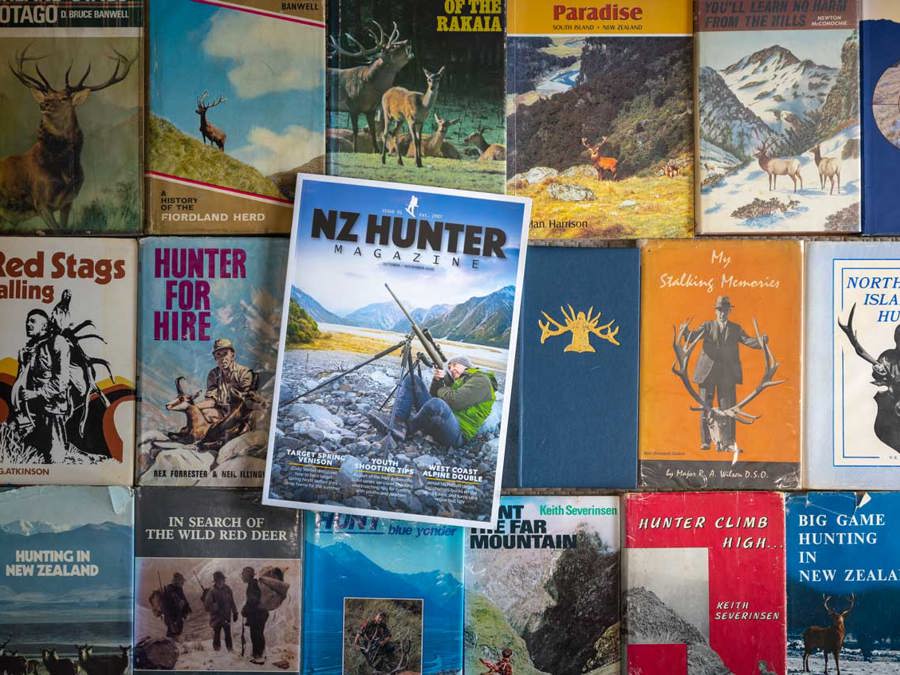
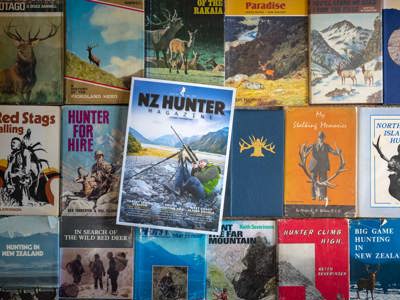
.jpg?width=200&height=149.9&mode=crop)
.jpg?width=200&height=149.9&mode=crop)
.jpg?width=200&height=149.9&mode=crop)
.jpg?width=200&height=149.9&mode=crop)
.jpg?width=200&height=149.9&mode=crop)
.jpg?width=200&height=149.9&mode=crop)
.jpg?width=200&height=149.9&mode=crop)
.jpg?width=200&height=149.9&mode=crop)
